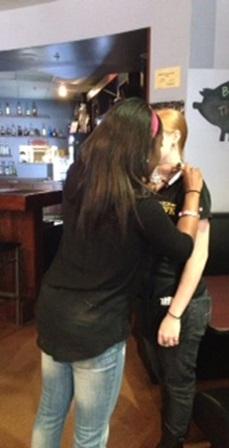Occupational Noise Exposure of Employees at Locally-Owned Restaurants in a College Town
Deirdre Green and T. Renée Anthony
Journal of Occupational and Environmental Hygiene, 12(7):489-499
Deirdre Green received research funding while she was an MS IH student to investigate noise exposures in restaurant workers. Funding from the NIOSH-funded Healthier Workforce Center for Excellence supported this study, which incorporated educating workers about hearing loss, both on and off the job. Her work examined how exposures vary over time and job title in a college town, with identification of sub-groups of workers and time of year factors associated with higher exposure risks.
ABSTRACT
While many restaurant employees work in loud environments, in both dining and food preparation areas, little is known about worker exposures to noise. The risk of hearing loss to millions of food service workers around the country is unknown. This study evaluated full-shift noise exposure to workers at six locally-owned restaurants to examine risk factors associated with noise exposures during the day shift. Participants included cooks, counter attendants, bartenders, and waiters at full-service restaurants with bar service and at limited-service restaurants that provided counter service only. Assessments were made on weekdays and weekends, both during the summer and the fall (with a local university in session) to examine whether the time of week or year affects noise exposures to this population in a college town. In addition, the relationships between noise exposures and the type of restaurant and job classification were assessed. One-hundred eighty full-shift time-weighted average (TWA) exposures were assessed, using both Occupational Safety and Health Administration (OSHA) and National Institute for Occupational Safety and Health (NIOSH) criteria. No TWA measurements exceeded the 90 dBA OSHA 8 hr permissible exposure limit, although six projected TWAs exceeded the 85 dBA OSHA hearing conservation action limit. Using NIOSH criteria, TWAs ranged from 69–90 dBA with a mean of 80 dBA (SD = 4 dBA). Nearly 8% (14) of the exposures exceeded the NIOSH 8-hr 85 dBA. Full-shift exposures were larger for all workers in full-service restaurants (p < 0.001) and for cooks (p = 0.003), regardless of restaurant type. The fall semester (p = 0.003) and weekend (p = 0.048) exposures were louder than summer and weekdays. Multiple linear regression analysis suggested that the combination of restaurant type, job classification, and season had a significant effect on restaurant worker noise exposures (p<0.001) in this college town. While evening/night shift exposures, where noise exposures may be anticipated to be louder, were not assessed, this study identified that restaurant type, job classification, time of week, and season significantly affected the noise exposures for day-shift workers. Intervention studies to prevent noise-induced hearing loss (NIHL) should consider these variables.
